- Fix: Your Location is Currently in Use Windows 10
- Solution 1: Disabling Location using Action Bar
- Solution 2: Turn location on or off for this device
- Solution 3: Turn location on or off for your account
- Solution 4: Change location access of different applications
- Solution 5: Changing location of your account using Registry
- Solution 6: Turning the location on or off for this Device
- Solution 7: Disabling the Location Notification
- Location in Windows 10: What You Need to Know
- You have a lot of control over your location settings in Windows 10
- Testing Windows 10 Location
- Does Windows Need to Know Your Location?
- Customize Your Location Settings
- Windows 10 Location Controls
- Allow Apps to Access Your Location on Windows
- Geofencing and Location History in Windows 10
- Windows Location Notifications
Fix: Your Location is Currently in Use Windows 10
Applications installed on your computer can access Windows 10’s location services to extract your physical location. You will see a system tray icon which says “Your location is currently in use” or “Your location has recently been accessed”. This icon can sometimes get really annoying.
If you want the icon to go away, you can disable location access entirely, control which applications have access to your location or even hide the notification bar so it doesn’t appear again and again.
Applications such as Maps use your location to discover your physical location. It will access your location and show it on the map. Even if you open the weather app, it accesses your location and displays weather according to your area.
Solution 1: Disabling Location using Action Bar
Windows 10 introduced an Action Center where you can find your application notifications as well as different tools to help you access quick settings on your computer. The action center also pertains all the past notifications until you clear them manually. This is very useful if you missed some notification and want to revisit it later on. We can also disable the location using the action center.
- Press Windows + A to launch the Action Center.
- Now click on the location quick button to toggle your location access on or off. It is as simple as that.
Solution 2: Turn location on or off for this device
You can also change the location of your device using the Settings. You need to be logged in as administrator to perform this function. If you (as an administrator) disable the location settings, all other users will also have their location disabled until you enable it again. However, if you enable it, the other users can either enable or disable their location from their accounts.
- Press Windows + S to launch the Search bar and type “Settings”. Open the first application which returns in the results.
- Now click on Privacy from the list of subcategories present in Settings.
- Now select Location using the navigation pane present at the left side of the screen.
- Now click on the “Change” icon present under the heading of Location. A new dialogue box will appear enabling you to either your location or off.
Solution 3: Turn location on or off for your account
If your administrator has already enabled the location of this device, you turn it on or off accordingly. Do note that these changes will be implemented to your user account only. The other accounts will have their settings different from yours.
- Press Windows + S to launch the Search bar and type “Settings”. Open the first application which returns in the results.
- Click on Privacy from the list of subcategories present in Settings.
- Now select Location using the navigation pane present at the left side of the screen.
- At the right side of the screen, you will a small subheading “Location service”. Underneath it will be an option to either toggle it on or off. Click it to change the location accordingly.
Solution 4: Change location access of different applications
You can also change location access of different applications using the settings. This method is particularly useful if you want to restrict the location access of a specific application while granting access to all the other ones.
- Press Windows + S to launch the Search bar and type “Settings”. Open the first application which returns in the results.
- Click on Privacy from the list of subcategories present in Settings.
- Now select Location using the navigation pane present at the left side of the screen.
- Scroll down to end of the page. Here you will see different applications listed with their permission right in front of them. Change the permission accordingly and exit the Settings when you are done.
Do note that other applications such as your internet browser can still provide your location information to websites who request it. You have to manually disable these settings by opening Privacy on your browsers and unchecking the access location.
Solution 5: Changing location of your account using Registry
You can also execute method 3 directly using a registry file. Registry files make changes to your registry enabling the setting to be turned off in the machine’s protocols. This is a very effective method if you want to avoid the technicalities and details while turning off the location for your account. Do note that similar to method 3, this solution will work if your administrator has enabled the location of your device. If the location is disabled as of method 2, you won’t be able to change it.
- Download the Registry file to disable your location and save it to an accessible location.
- Double-click the file to run. If you are prompted whether you want to run this file, press Yes.
- The registry values will be changed and the location of your account will be disabled.
You can also enable the location of your account using this method.
- Download the Registry file to enable your location and save it to an accessible location.
- Follow the steps 2 and 3 listed above.
Solution 6: Turning the location on or off for this Device
You can also carry out solution 2 using registry files. This method is particularly useful if you don’t want to indulge in additional menus and want the task to be completed using a single click. Do note that you need to be logged in as an administrator to execute the command. If you (as an administrator) disable the location settings, all other users will also have their location disabled until you enable it again. However, if you enable it, the other users can either enable or disable their location from their accounts.
- Download the Registry file to enable the location of this device and save it to an accessible location.
- Double click to open it. If you are prompted by the system whether to open the file or not, click Yes.
You can also disable the location of this device using the registry editor as well.
- Download the Registry file to disable the location of this device and save it to an accessible location.
- Double click to open it. If you are prompted by the system whether to open the file or not, click Yes.
Solution 7: Disabling the Location Notification
If you don’t want to make any changes to your current location settings but don’t want to see the notification, you can easily disable it. This means that your location will still be accessed but you won’t be notified about it.
- Press Windows + S to launch the search bar and type “settings” in the dialogue box. Open the first result which comes forth.
- Click on “System” from the list of subcategories present in settings.
- Select “Notifications and actions” using the navigation pane present at the left side of the screen.
- Scroll down until you see the Locationnotification Toggle it off. Now the notification won’t be shown on your taskbar.
- You can also disable the notifications for all the applications by toggling the option “Get notifications from apps and other senders”.
Location in Windows 10: What You Need to Know
You have a lot of control over your location settings in Windows 10
With so much importance placed on mobile devices these days, PCs are starting to borrow features from their smaller-screened companions. One such feature in Windows 10 is built-in location services. True, your laptop or desktop doesn’t have GPS capability, and many (but not all) lack the ability to communicate with wireless cell towers.
Nevertheless, Windows 10 can figure out where you are using Wi-Fi positioning, as well as your device’s Internet Protocol (IP) address. The results are pretty accurate.
Instructions in this article apply to Windows 10.
Testing Windows 10 Location
If you want to test how well Windows 10 knows where you are, open the built-in Maps app.
Type Maps in the search box next to the Start button.
Select Open on the Maps app.
Select Yes if asked to allow Maps to know your precise location.
Look for a location marker (a small solid circle inside a bigger circle) on the map where it thinks you’re located.
If the map doesn’t fly to your location, click the location marker on the map’s right-hand control panel to try again.
Does Windows Need to Know Your Location?
Now, when we say Windows 10 «knows» your location, we don’t really mean that someone is becoming aware of your present surroundings in real-time. It just means that your PC is storing your current location in a database and will share it with apps that request it — as long as the app is authorized to have it. Windows 10 deletes your location history after 24 hours, but it still may live on in the cloud, stored by other apps and services.
Location information offers many benefits. It lets you quickly find where you are on a maps app; a weather app can deliver local forecasts based on your location, and apps such as Uber can use it to send a ride to your location.
Even though location can come in handy, it’s not an absolute necessity for all users, and Microsoft gives you enough control to turn it off. If you do decide to go location-less, keep in mind that you won’t be able to use Cortana, which requires your location history to function. The built-in Maps app, meanwhile, doesn’t require your location, but without it, Maps can’t show your current location to within a few feet.
Customize Your Location Settings
To make changes to this feature, access Location settings.
Select Start and choose the Settings icon.
Select Privacy in the Windows Settings window.
Select Location in the left pane under App Permissions.
Windows 10 Location Controls
There are two basic location controls: one for all users with accounts on your PC and one specifically for your user account.
The setting for all users on your PC is near the top where you see a gray button called Change. It might say Location for this device is on, which means every user can use location services on this PC.
Select Change and the toggle switch opens, enabling you to stop every user account on the computer from using location services.
Allow Apps to Access Your Location on Windows
The next button below Allow Access to Location on This Device is Allow Apps to Access Your Location. This is a per-user setting to turn location services on or off. Using the per-user option is a good idea if one person in your house wants to use location services while others don’t.
In addition to covering just your basic on/off settings for location, Windows 10 also lets you set location permissions on a per history basis. Scroll down the screen to choose apps that can use your location.
Here, you’ll see toggles for every app that uses location. If you want to permit Maps to use your location, but don’t really see the point of allowing it for Twitter, you can do that.
Geofencing and Location History in Windows 10
Below the list of apps, you’ll also see a paragraph about geofencing. This is a feature that allows an app to monitor your location and then react when you leave a pre-defined area. Cortana, for example, can deliver a reminder such as buying bread when you leave work.
There are no geofencing settings: it’s part and parcel of the regular location settings. All this area does is let you know if any of your apps are using geofencing. If an app is using the feature, this section says, «One or more of your apps are currently using geofencing.»
Under Location History, you can erase your location history manually by selecting Clear. If you don’t use this setting, your device will erase the location history automatically after 24 hours.
Windows Location Notifications
The last issue to know about is that Windows 10 will alert you every time an app is using your location. It won’t show up as a notification that distracts you. Instead, you’ll see the location marker appear on the far right of your taskbar. When that happens an app has used your location.
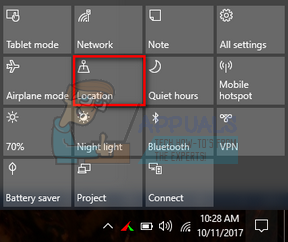

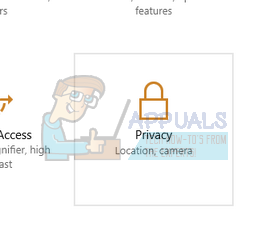
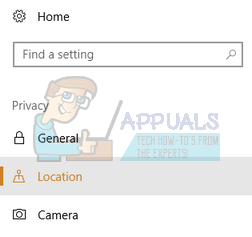
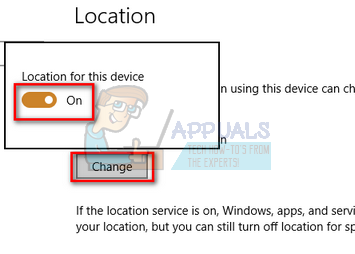
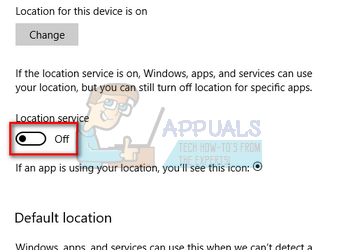
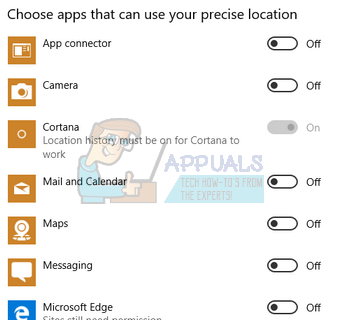
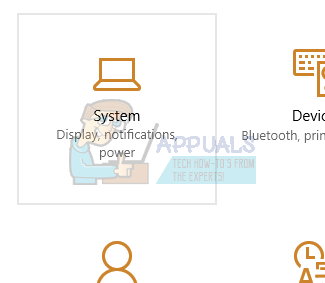
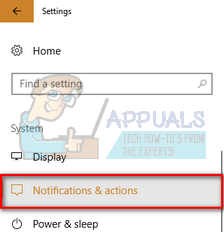
:max_bytes(150000):strip_icc()/001-location-in-windows-10-4032883-4d60380cb8254983b45d111a09eb1b20.jpg)
:max_bytes(150000):strip_icc()/002-location-in-windows-10-4032883-415d85dc038e4473b9136e9534de4558.jpg)
:max_bytes(150000):strip_icc()/003-location-in-windows-10-4032883-26faeaf1a199464e8a12b57e27240382.jpg)
:max_bytes(150000):strip_icc()/004-location-in-windows-10-4032883-39ac34e220d44008b70eaae3f595e951.jpg)
:max_bytes(150000):strip_icc()/005-location-in-windows-10-4032883-71b75755f46843c984df800f474946c4.jpg)
:max_bytes(150000):strip_icc()/006-location-in-windows-10-4032883-5255e04cba50408ba9e6a6f249a1fcb8.jpg)



